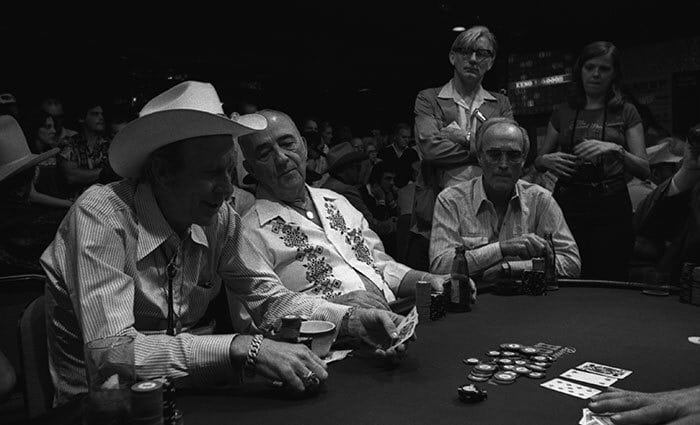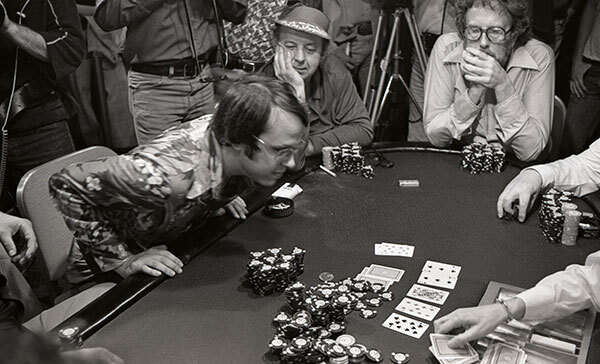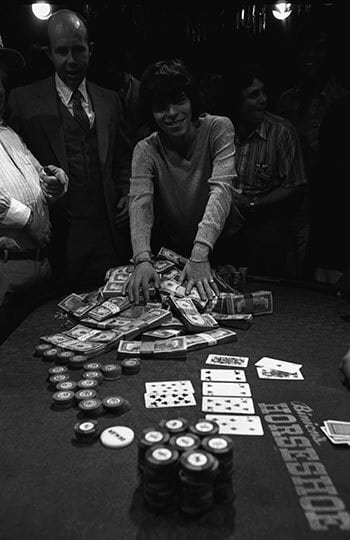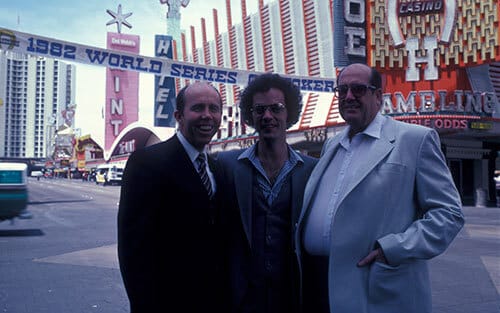The History of the World Series of Poker: 1970-1989

The History of the World Series of Poker: 1970-1989
The World Series of Poker is currently the most popular poker festival in the world. With millions of dollars won year in and year out, this legendary series of poker tournaments, bracelet events, and cash games are a poker player’s paradise. Staged in Las Vegas, the World Series of Poker has been running annually for over half a century at venues as iconic as Binion’s Horseshoe, The Rio and its new home of Bally’s and Paris, with Bally’s set to become the Horseshoe Las Vegas in 2023.
The World Series wasn’t always so large, however, with just seven men contesting the first ever ‘Main Event’ by a secret vote. So how did poker grow from such modest beginnings into the phenomenon that it is today? The story of the World Series of Poker starts in 1970 in Sin City.
The First ‘Main Event’ Vote
Over half a century ago, seven men gathered in Las Vegas for the first World Series of Poker. But the initial World Series of Poker was a far cry from the hugely popular, 100+ event festival that it is today. Once upon a time, it was invitation-only and those invitations were controlled by Benny Binion. In 1970, Binion invited seven of the very best poker players – many of whom travelled around looking for the best game as opposed to today where you can always find a good game playing online poker. These seven gathered in Las Vegas, at the Horseshoe Casino, to play cash games and a tournament before voting on who they thought was the best poker player in the country, and therefore the ‘World Series Champion’.

Voting went as you might expect, with each man voting for themselves. On the second secret ballot, where no one was allowed to vote for themselves, it was Johnny Moss, later known as The Grand Old Man of Poker, who was announced as the first ‘world champion’ of poker.
The remainder of the initial World Series of Poker was a series of cash games in a variety of formats. Back in those days, variants such as Five-Card Stud, 2-7 Lowball Draw, Razz, Seven-Card Stud, and Texas Hold ’em were king. It was the final poker game on that list which would go on to redefine poker over the next few decades.
The following year, Moss did not need a vote to be declared the winner. While only 6 competitors made it down to Las Vegas, it was Johnny Moss who won the event, winning the trophy – a small silver cup – for the second time. This was the first and only time the number of players would decrease for the WSOP Main Event until 2007, after the passage of UIGEA – but that is a story for another time.
Texas Dolly and Ten-Deuce
Johnny Moss would win a third WSOP Main Event in 1974, but the story of the 1970s, at the biggest poker tournament in the world, was not that of the Grand Old Man of poker. Doyle Brunson had been there from the start of the Main Event and saw it grow to 22 players by 1976. Each player put up what has become an ever-present buy-in of $10,000 to participate in this legendary event. Moss had triumphed in the winner-take-all poker tournament for the $30,000 prize in 1970, but Brunson, who won his first World Series of Poker championship in 1976, earned $220,000 and the inaugural WSOP Bracelet with a ten-deuce, the hand that would, after the events of the following year, be forever associated with him.
The following year, 1977, Doyle Brunson came back and won the World Series of Poker, this time outlasting 33 opponents, claiming $340,000 in prize money and his second World Series of Poker bracelet. What made this victory unique, even more than Doyle being the first person to win this poker tournament back-to-back, was he that his winning hand in both poker tournaments was the ten-deuce. This hand, which has become known as ‘Texas Dolly’, or ‘Doyle’s Hand’, was just the beginning of what became the legend of the ‘Godfather of Poker’.

Brunson was joined in the record books by many others from that early decade, including well known characters such as Brian ‘Sailor’ Roberts, Puggy Pearson and Bobby Baldwin, all who have won a WSOP Main Event gold bracelet. Other tournaments were eventually added into the mix along with the cash games. The introduction of the gold bracelet for WSOP Main Event winners started in 1976, a tradition that has continued. All of the winners of the World Series of Poker Main Event prior to 1976 were retroactively awarded a gold WSOP bracelet.
Ungar Starts the Decade with Back-to-Back Wins
The Texan with the cowboy hat would become a famous symbol of the game in the first decade of poker’s World Series, but the next decade belonged to a very different set of personalities. In 1980, Stu ‘The Kid’ Ungar took down the World Series of Poker Main Event in effortless fashion as the king of Gin Rummy in Sin City proved that he was just as proficient in poker games.
Ungar won the 1980 Main Event against 72 other poker players. With the prize pool now being split amongst the top poker players and not a winner-takes-all event, Ungar took home $385,000, roughly the same prize with inflation as Brunson was awarded four years earlier.
A year later, Ungar did what no one had done since ‘Texas Dolly’, winning back-to-back Main Events. With 75 entrants in 1981, Ungar’s victory was all the more remarkable and a star was born. Sadly for the World Series of Poker icon, Ungar struggled with substance abuse and gambling in the years that followed, but his poker story wasn’t over, even if no-one knew it – or would have believed it – at the time.
In Ungar’s absence others moved into the spotlight. Jack ‘Treetop’ Strauss conquered the tallest of orders. In 1982, this giant of a man, he stood 6’6”, won the WSOP Main Event after being down to just a single $500 poker chip, according to the stories. It is believed that this is the origin of the poker saying ‘a chip and a chair’. The next year, Tom McEvoy became the first poker player to win the big one from a satellite entry, the first of his two major poker achievements that altered the course of the World Series of Poker forever (the other being his successful argument that the World Series of Poker venue should be a non-smoking event).

Chan and Hellmuth Provide Thrills as Eighties End
As the 1980’s progressed, the inclusion of satellites, a growing sense of grandeur around the Main Event in the world of poker, and the overall size of the festival catapulted the World Series of Poker to the nation’s living rooms via televised main event coverage and highlights. By 1987, over 2,000 poker players took to the felt across the entirety of the World Series of Poker’s event schedule, all 12 events, and the Main Event was the biggest it had ever been.
Racing along like a runaway train in 1987 was Johnny Chan. Known as ‘The Orient Express’, Johnny Chan hailed from the Far East. He ploughed through 150 opponents before facing Frank Henderson heads-up for the poker championship. Johnny Chan beat Frank Henderson to win the title and took home the $625,000 top prize. Emulating Doyle Brunson and Stu Ungar, Johnny Chan would win back-to-back open WSOP Main Events as he claimed the win in 1988 too, getting the better of Erik Seidel in a hand that lives on in poker folklore and was immortalised in the movie Rounders.
With a ‘look to the sky’, Chan – the only man to win 2 Main Events when the number of opponents can be measured by the hundreds – convinced Seidel to shove after checking the turn with a strong hand. Chan won the poker tournament to take the title of world champion in 1988.
Chan looked unstoppable and in 1989 he found a way to reach the latter stages yet again. Spurred on by the offer of an NBA Championship Ring from Los Angeles Lakers owner Jerry Buss, if he could win three in a row, ‘The Orient Express’ lived up to his nickname as he raced to the end, facing heads-up against a young unknown poker player.
The unknown 24-year-old newbie, Phil Hellmuth Junior, was about to become a poker hero overnight. Wearing Walkman headphones and a lop-sided grin, the young maths whiz became the youngest ever winner of the Main Event, a record that would stand until 2008. Hellmuth’s triumph denied Chan three in a row, and ‘The Orient Express’ has not been back to the final table since. Meanwhile Hellmuth, would go on to become one of the, if not the most successful poker player in the history of the World Series of Poker.
Hellmuth’s victory for $755,000 in an event populated by 178 players was seen as a watershed event, after all if a 24-year-old unknown could win, why couldn’t anyone?
Over the next two decades, that was to prove the case, as a variety of winners took home the title of world champion from Las Vegas.
In Part 2 of this series, we look at how poker continued to grow until one fateful year, a winner, with a very appropriate surname, changed the course of poker forever in a single moment that had a spectacular ‘effect’ on the game.

About the Author: Paul Seaton has written about poker for over 10 years, interviewing some of the best players ever to play the game such as Daniel Negreanu, Johnny Chan and Phil Hellmuth. Over the years, Paul has reported live from tournaments such as the World Series of Poker in Las Vegas and the European Poker Tour. He has also written for other poker brands where he was Head of Media, as well as BLUFF magazine, where he was Editor.
Whether you’re a fan of high-stakes cash games or the excitement of multi-table poker tournaments, GGPoker is the premier destination for poker enthusiasts. For those aiming to compete for a prestigious WSOP bracelet, push through the ranks for a WSOP Circuit ring, or simply hone their strategies in classic games or poker formats, GGPoker has something for everyone. The platform offers a seamless online poker experience, with innovative features like Smart HUD, PokerCraft, and integrated staking, designed to elevate your game. Whether you’re grinding your way up in daily cash games or competing for life-changing prizes in major online series, GGPoker provides the best environment to play, improve your poker skills, and succeed in the world of online poker. And if you are not sure where to start, you can always play free poker games and learn at the GGPoker School.
